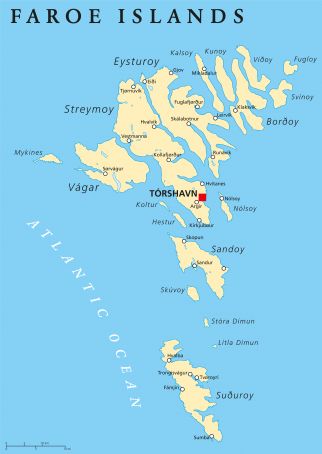Looking at a map of the European continent, you will find the Faroe Islands right at the top, halfway between Iceland and Norway.
Often described as one of the last frontiers of Europe, the Faroe Islands is a territory in perennial struggle against harassing invasions, whether it be excess tourism or covid-19. The islands, however, have always shown great capacity for resilience and action. Inhabitants here have a rare touch for hospitality. For this and much more, the islands are a candidate to be one of the most intriguing spring destinations in the coming years.
What are the Faroe Islands?
A little survey among friends and colleagues, with the question 'What do you know about the Faroe Islands?', will reveal uncertain answers. Greenland? Iceland? Norway? Denmark?
Also read: The Helheim glacier in Greenland is melting
The right answer is the last one: the Faroe Islands are a Danish archipelago. They emerge halfway between Copenhagen and Iceland, separating the Atlantic Ocean from the Norwegian Sea, and are the new frontier for lovers of vacations not made only of beaches, cocktails and sunbathing. In this part of the world, breathtaking views, walks in uncontaminated nature and an approach to food almost unheard of, are the main features.
Also read: The Eysturoy tunnel opens in Denmark
The lush green Faroe Islands, and their fifty thousand inhabitants, offer a well- balanced mix of folk traditions and technological leaps, locally- sourced ingredients and innovative recipes. The classic grass thatched- roof cottages are intertwined with eco-design hotels, perfectly integrated in the surrounding environment.
Why are the Faroe Islands a top destination for spring 2021?
This archipelago, which consists of eighteen islands, is the perfect destination for those who want to disconnect from the city and immerse themselves in an unspoiled landscape that is intended to remain unchanged.

Lost in the middle of the sea, of Danish territory, these islets are almost totally uninhabited, but well connected to each other. The capital is Tórshavn, the smallest capital in the world.
Take a walk in Reyni, the oldest part of the city, with its colorful houses and typical grass roofs, and you can't miss the National Gallery and the Nordic House.
The Faroe Islands are the perfect example of how modern architecture can coexist with a practically virgin landscape. It is where about 300 species of birds have decided to live, and bird watchers will be in heaven between excursions on foot or by boat. They are islands little beaten by mass tourism in the sea of Northern Europe: a place where nature reigns supreme, inhabited by few people (and often many sheep), with a slow and peaceful pace of life.
Also read: Denmark apologizes to Inuit children
The Faroe Islands have the reputation of being an archipelago very attentive to its protection. In fact, since 2019 a government measure has been in place to limit excess tourism. In April, the islands are closed to visitors for two days, while inhabitants work on a voluntary basis to restore trekking paths after winter. In other words, they put everything in it’s place; they have prepared to welcome travelers.
The opportunity to get to know the Faroe Islands better comes thanks to the local Faroese airline, Atlantic Airlines which offers nonstop flights from major European cities to Vagar Island.
The views of the Faroe Islands
In the Faroe Islands you can find sheer cliffs, towers of volcanic rock, roaring waterfalls, remote fishing villages, and remains of Viking settlements. In late spring, when the climate is drier and more forgiving, the Faroe Islands awaken from winter hibernation to the curlew birds singing among the high moors. Adventures in seabird colonies in Mykines and Vestmanna are highly recommended.
Movie Set
The Faroe Islands were the favorite film set of Swedish director Ingmar Bergman in the 1960s. During a location scouting for his film Through A Glass Darkly, he remained enchanted by the volcanic stacks in the middle of the sea wrapped up by a storm. His love was so immense that Bergman adopted the Faroe Islands: it was the setting for six other films and above all it became his home, where he still rests today.
Also read: Melting ice patch uncovers ancient hunting arrows
Where to Sleep
Hotel Føroyar, in the capital. Designed by renowned Danish architecture firm Friis & Moltke A/S, it was built to respect the landscape around it. So much so that the structure blends in perfectly with the surrounding rocks, both because of how it is positioned and because of the green grass roof. Double Room: from €67
Where to Eat
The chef of globally- acclaimed restaurant Koks near Lake Leynar (a remote destination), is a young culinary expert dedicated to preserving Faroese flavors. The menus found on the Faroe Islands offer a remarkable and often completely new gastronomic experience. After all, food and local recipes are the gateway to getting to know the people, the land that hosts them, and the traditions that make them unique. Koks Tasting Menu: €260
General Info
View on Map
The Faroe Islands in spring
Faroe Islands








